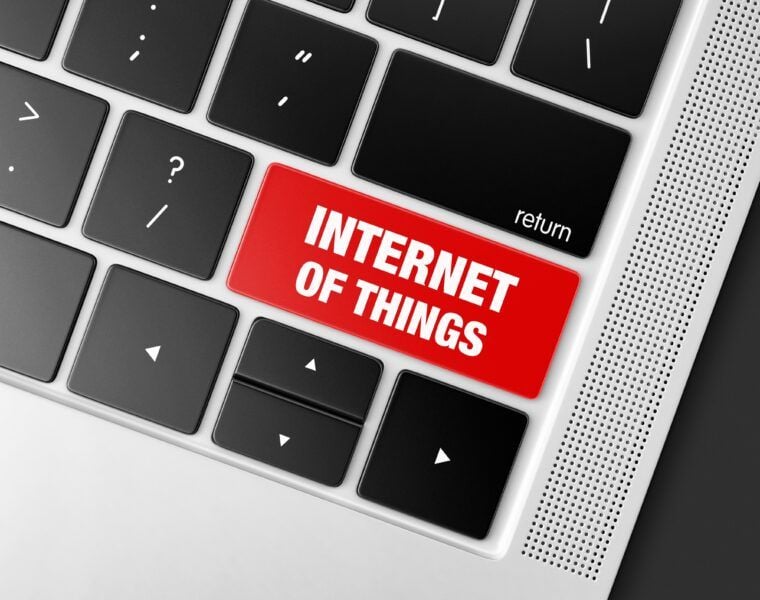IoT Examples: 5 Best Ways Connected Devices are Revolutionizing the World

The Internet of Things (IoT) isn’t just a term you come across in tech magazines or industry reports; it’s the reality of the interconnected world we live in today. Think about the smart thermostat that adjusts the room temperature just how you like it or the fitness tracker that nudges you to take those extra steps. These are just a couple of IoT examples that touch our daily lives. However, IoT extends far beyond these personal devices. From optimizing traffic flow in bustling cities to enhancing precision in agriculture, IoT’s applications are vast and transformative. As we journey through this topic, let us uncover the depth and breadth of IoT, especially spotlighting IoT examples in daily life and their impact on our world.
In this blog, you will learn:
- How Does the Internet of Things (IoT) Works?
- What are Some Real-World Examples of IoT applications?
- Types of IoT Applications
- How Does IoT Work? Example of an IoT System
- Benefits of IoT for Organizations
- Potential Drawbacks of IoT as a Technology
- Why is IoT Important?
- Best Jobs in IoT
- How to Gain IoT Skills
- Frequently Asked Questions About IoT
How Does the Internet of Things (IoT) Works?
When we talk about what is Internet of Things, we’re referring to a vast network of interconnected devices. These aren’t just ordinary devices but embedded with sensors, software, and other technologies. Additionally, these components allow them to connect and exchange data with other devices and systems over the Internet. Picture, for a moment, a smart refrigerator; beyond its primary function, it can monitor food expiration dates, suggest recipes based on available ingredients, and even sync with favorite grocery stores for home deliveries! In essence, all these functionalities are made possible because of IoT.
 What are Some Real-World Examples of IoT Applications?
What are Some Real-World Examples of IoT Applications?
1. Smart Homes
The smart home is one of the most relatable IoT examples in daily life. Think of voice-activated assistants like Alexa playing your favorite tunes, smart thermostats like Nest that adapt to heating and cooling preferences, and security systems like Ring that can be monitored and controlled remotely. These devices, when combined, create a cohesive ecosystem, thus making our homes smarter and more efficient.
2. Wearable Health Devices
Wearable devices have become an integral part of our daily routines. Beyond tracking steps or monitoring sleep, devices like the Fitbit or Apple Watch monitor vital signs and set medication reminders. They can even detect irregular heartbeats or falls, potentially alerting emergency services and saving lives.
3. Smart Cities
When we ponder on what is the Internet of Things in a macro sense, cities globally stand out. This is all about integrating IoT technology to manage traffic through smart traffic lights, automate waste management, monitor air and water quality, and optimize energy consumption through smart grids. As a matter of fact, all these lead to safer, cleaner, and more efficient urban environments.
4. Agriculture
The age-old farming industry is also undergoing a digital transformation. IoT examples here include sensors that monitor soil health and moisture levels, drones that map and analyze fields, and smart irrigation systems that ensure crops receive optimal water. As a result, this tech infusion maximizes yields and promotes sustainable farming practices.
5. Retail
IoT is redefining the retail landscape. Smart shelves in stores alert staff when stock is dwindling, smart mirrors in dressing rooms allow customers to virtually try on different outfits, and beacon technology provides personalized advertising to shoppers based on their in-store behavior.
ALSO READ: What is Information Technology? Here’s Everything You Need to Know About the IT World
Types of IoT Applications
1. Health Care
The impact of IoT on health care is profound. Some examples are smart beds in hospitals that adjust to ensure patient comfort, wearable devices provide real-time patient data to medical professionals, and remote patient monitoring devices like glucose monitors ensure patients receive continuous care—even when they’re miles away from a medical facility.
2. Transportation
The era of smart mobility is upon us. In fact, connected cars equipped with IoT technology offer real-time traffic updates, self-parking capabilities, and even predictive maintenance alerts. Consequently, public transport systems leverage IoT to adjust routes based on real-time data, thus ensuring timely service and reduced congestion.
3. Manufacturing
Today’s factory floors are abuzz with IoT in action: Machines equipped with sensors predict maintenance needs, production lines adjust in real time to changes in demand, and RFID tags on products streamline inventory management. In a nutshell, all this makes the entire manufacturing process more efficient and reliable.
4. Energy
The energy sector is harnessing the power of IoT to revolutionize how we consume power. While smart grids ensure efficient energy distribution, homes equipped with solar panels and IoT technology feed excess energy back into the grid, and smart meters give consumers real-time data on their energy consumption. This further helps with energy conservation.
5. Consumer Electronics
Our daily gadgets are not just smart; they’re IoT-enabled. Interestingly, Smart TVs recommend shows based on our viewing habits, washing machines adjust wash cycles based on laundry load, and smart speakers like Google Home or Amazon Echo integrate with other home devices, offering a seamless tech experience.
ALSO READ: Learn How Digital Technologies Can be Used in Education Today
How Does IoT Work? Example of an IoT System
Let’s consider a smart factory. Sensors on machinery continuously monitor performance, detecting any anomalies that might indicate a need for maintenance. Furthermore, RFID tags on products and materials ensure real-time inventory tracking. As this data flows in, it is funneled to a centralized system where advanced analytics are applied. As a result, these insights guide decision-making, optimizing processes, and ensuring maximum efficiency. This interconnectedness, the essence of what is Internet of Things technology, is what drives modern industries.
ALSO READ: Top 10 Highest Paying Tech Jobs for 2023 and Beyond
 Benefits of IoT for Organizations
Benefits of IoT for Organizations
1. Efficiency and Productivity
The integration of IoT systems has revolutionized the way businesses operate. In essence, human resources can be redirected to more strategic activities by automating tasks that were once manual, such as inventory tracking or machinery maintenance. Additionally, this shift not only boosts overall productivity but also ensures that operations run smoothly. For instance, in a smart factory setting, IoT sensors can detect when a machine is about to fail, allowing for timely intervention and minimizing downtime.
2. Cost Savings
Delving deeper into the financial benefits, the real-time monitoring capabilities of IoT devices can lead to significant cost savings. Largely, predictive maintenance, a prime example of what is IoT technology at its best, helps in pre-empting expensive equipment breakdowns. Hence, this proactive approach, combined with energy-saving measures in smart buildings, ensures that businesses operate in optimal financial health.
3. Data-Driven Decisions
The influx of data from IoT devices equips organizations with a treasure trove of insights. Consequently, this data-driven approach, bolstered by advanced analytics, allows for better product development, optimized operations, and even predictive market analysis. For instance, retailers can analyze customer footfall patterns using IoT sensors, tailoring in-store experiences and enhancing customer satisfaction accordingly.
4. Enhanced Customer Experience
On the customer front, the wonders of IoT are evident in our daily lives. Furthermore, smart home devices, a classic example of IoT examples in daily life, learn and adapt to user preferences, from adjusting room temperatures to suggesting music. Similarly, retailers leveraging IoT can offer personalized discounts or shopping experiences, thus ensuring customers feel valued and understood.
5. Innovation
IoT stands as a beacon of innovation. Hence, businesses can explore novel solutions, products, and services by offering new methodologies and data-driven insights. Additionally, a smart city, optimizing traffic flow and energy consumption using IoT, exemplifies how traditional systems can be innovatively revamped.
Potential Drawbacks of IoT as a Technology
1. Security Concerns
The vast interconnected nature of IoT presents significant security challenges. A single vulnerability in one device could potentially compromise an entire network. Furthermore, this risk underscores the importance of robust security protocols, especially as cyberattacks become more sophisticated.
2. Privacy Issues
Venturing into the realm of privacy, the constant data collection by IoT devices raises eyebrows. Moreover, these questions often deal with data storage, access, and usage. For instance, while offering convenience, smart home devices also collect vast amounts of personal data, necessitating stringent privacy measures.
3. Complexity
Diving into operational challenges, the complexity of managing myriad connected devices grows as the IoT ecosystem expands. So, ensuring that each device, with its unique software and firmware, functions harmoniously within a larger system can be daunting.
4. Cost
From a financial perspective, while the long-term benefits of IoT are undeniable, the initial investment can be hefty. Small businesses, in particular, might find the upfront costs of IoT infrastructure and integration a significant barrier.
5. Interoperability
With a plethora of devices from diverse manufacturers, ensuring seamless communication and integration is a challenge. Thus, standardizing communication protocols and ensuring device compatibility are crucial for the seamless functioning of IoT systems.
ALSO READ: What is Information System? Definition, Examples, & Facts
Why is IoT Important?
Today, the fusion of the physical and digital realms is not just imminent; it’s already here. In essence, IoT is at the heart of this fusion. The ability to gather, analyze, and act upon data in real-time has transformative potential. From smart homes enhancing our living experiences to industrial IoT fine-tuning manufacturing processes, the significance and potential of IoT are both vast and far-reaching.
ALSO READ: Importance of Certification Courses – Pursue Business and IT Certification Courses for Career Growth
Best Jobs in IoT
1. IoT Developer
These trailblazers are responsible for crafting the applications and systems that underpin IoT devices. Their work ensures that when someone asks, “What is IoT technology?”, there is a tangible answer in the form of innovative devices and solutions.
2. IoT Architect
Beyond coding, these visionaries conceptualize and design the overarching structure for IoT implementations. Moreover, their expertise ensures that devices, software, and systems integrate seamlessly, offering optimal functionality.
3. Data Scientist
In our data-saturated world, these experts stand as sentinels. They sift through the deluge of data generated by IoT, harnessing analytics to extract meaningful insights that inform business strategies and decision-making.
4. IoT Security Specialist
Given the aforementioned security challenges associated with IoT, these guardians are indispensable. Further, their expertise ensures the safety, integrity, and resilience of IoT systems, safeguarding them against potential threats.
5. IoT Product Manager
These professionals oversee the entire lifecycle of IoT products. Additionally, their purview spans ideation and development to testing, deployment, and market feedback, ensuring IoT products resonate with users and succeed in the market.
How to Gain IoT Skills
1. Certification Programs
Many reputable institutions offer specialized courses and certifications in IoT. Moreover, these programs often incorporate real-world IoT examples, allowing students to understand the practical applications of their theoretical knowledge. For instance, a certification might include a module on smart home integrations, showcasing how various IoT devices work in tandem.
2. Online Courses
Many online platforms have a wealth of IoT courses. These courses, ranging from beginner to advanced levels, often delve into specific IoT examples, like wearable health devices or smart agriculture, ensuring a comprehensive understanding of the subject.
3. Workshops
Diving into a more hands-on approach, workshops focused on IoT offer participants a chance to work directly with IoT devices and systems. Additionally, through these workshops, learners can engage with real-world IoT examples, such as setting up a smart lighting system or programming a drone, thus providing them with invaluable practical experience.
4. Networking
Networking plays a pivotal role in skill acquisition beyond formal education. Consequently, joining IoT communities, forums and attending conferences not only provides a platform to discuss and learn from real-world IoT examples but also offers opportunities to connect with industry experts, innovators, and fellow enthusiasts.
5. Reading and Research
The dynamic nature of IoT means that the field is always evolving. Hence, staying updated with the latest advancements, breakthroughs, and IoT examples is crucial. Additionally, regularly reading books, articles, journals, and even case studies can offer insights into current trends in and future potential of IoT.
ALSO READ: Securing the Ways of Work in a Virtual World
Frequently Asked Questions About IoT
1. What is an Example of Internet of Things (IoT) Security?
A prominent example of IoT security is the encryption of data transmitted between IoT devices. Further, this encryption ensures that any data, whether it’s from your smart doorbell or industrial sensors, remains inaccessible to unauthorized entities. Additionally, multifactor authentication for device access is another layer of security commonly implemented.
2. What is IoT (Internet of Things) Class 11?
“IoT Class 11” typically refers to an introductory curriculum or module taught at the high-school level. As a matter of fact, this course, besides introducing students to the foundational concepts of IoT, also delves into its real-world applications and potential future developments.
3. How Does IoT Impact Data Analytics and Decision-Making?
IoT continuously feeds vast amounts of real-time data into analytics systems. Consequently, once processed and analyzed, this data offers actionable insights that can significantly influence business strategies, optimize operations, and drive more informed decision-making across sectors.
4. Are There Any Security Concerns Related to IoT Devices?
The interconnected nature of IoT devices does present challenges. Indeed, with each device potentially acting as an entry point, there is an increased risk of cyberattacks, data breaches, and unauthorized access. Thus, ensuring robust security protocols for these devices is paramount.
5. How Can Businesses Leverage IoT to Improve Efficiency and Productivity?
Businesses stand to gain immensely from IoT integration. As a matter of fact, by harnessing IoT for real-time monitoring, businesses can proactively address issues, reducing downtime. Automation, another facet of IoT, streamlines operations. Additionally, predictive maintenance, powered by IoT sensors, can preempt equipment failures. With the data-driven insights IoT provides, businesses can refine strategies, optimize processes, and ultimately boost efficiency and productivity.
In conclusion, if you want to delve deeper into IT, IoT, and IoT examples, consider enhancing your skills with Emeritus’ specialized courses. Check out these IT courses to kick-start and elevate your journey in the realm of technology today!
Write to us at content@emeritus.org





